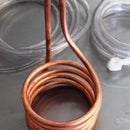Introduction: Polished Aluminum Bauble Ornaments From Tin Foil
As I was thinking about what to make the Things for their ornaments this year, I thought this might be a new fun technique to try. And pretty easy to turn into ornaments. I also thought the shiny polished Aluminum would have a nice retro mercury-glass look...which it did, kinda sorta, and they looked awesome on the Christmas tree.
'Japanese polished Aluminum foil balls' have been popping up all over the place out there - these balls are made from nothing more than a roll of tin foil, balled up and compacted by hammering, then sanded and polished to a beautiful shine. That, and many hours of love. There are plenty of videos on YouTube showing the process of making polished Aluminum balls, also credit to this Instructable: https://www.instructables.com/id/How-to-Make-a-Pol... which got me started on the process of making the ornaments.
As I was researching, I didn't find all answers to my questions out there on the interwebs, so hopefully mine will answer some additional questions for others in the community (like size of finished balls, techniques for minimizing creases, etc.)
So my first question was: How much foil will I need to make an ornament ball, say, 3 inches in diameter?
I couldn't seem to find an answer, and everyone was using different foils of different sizes and thicknesses, so I just bought a roll of Reynolds Wrap (200 Sq ft size, or 66.67 yards x 12"), fairly commonly available across the US, and used the whole roll of foil to find out for myself. The resulting ball was way too big for a tree ornament, about 5.5" diameter and heavy (850g/1lb 14 oz!). So I decided to go for half the roll of foil for each of the ornament balls. These turned out to be just over 3.5" diameter...still slightly larger than I'd wanted but good enough as I didn't want to make any more at this point!
They were not too heavy (at ~14oz, still the heaviest ornaments on the tree), so did need to be hung on lower branches of the tree. Slightly smaller balls would have been ideal (my suggestion for others is to use a roll of the Reynolds 75 sq ft foil per ball, which should be perfect).
The larger ball didn't go to waste btw - it was turned into a giant ornament and hung in the dining room window, using 20lb fishing line.
Supplies Needed
- Aluminum Foil (I used this Reynolds Wrap: https://tinyurl.com/y8uoeerc)
- Sandpaper (multiple grits, about 120 to 3000 grit. I got these: https://tinyurl.com/y6w3pmw9)
- Aluminum polish (https://tinyurl.com/ya7ozdpx)
- Cloths for polishing (I used cut up old white T shirts)
- Eye hooks (I used 1 3/16" 210 hooks: https://tinyurl.com/yct8w7y8)
- End caps from cigar tubes
- Fishing line (12lb or higher)
Step 1: Start Balling Your Tin Foil
So I already knew that one whole roll of Reynolds Wrap would result in a way-too-large bauble. How much to use then? I went for easy and made two balls from the single roll. Instead of measuring by length, I went by weight...weighed the whole roll, then aimed for half that amount as I was balling up the first one, weighing it until it reached what I was looking for. They ended up being roughly the same weight (within 25g of each other) which worked out great. The weight of the cardboard inner tube I felt was negligible so hadn't worried about it.
From making the first (giant) ball, I knew that I had an issue to solve - a flap created as I finished balling up the foil ball. The flap wouldn't go away, and interfered with sanding and polishing. After all that hammering, it was an unsightly and jagged sharp edge - not good. I hadn't paid any attention to it at the time, but knew I didn't want a repeat with these ones.
My solution seemed to work well: the ball is formed by rolling and balling the roll of foil. Turning as you go, the ball gets bigger and bigger. As you get to the end, roll the last few turns on the straight and crimp the ends together- meaning that you finish with a crumpled 'ear' on each side, sticking out from the ball.
The next step involves a whole lot of gently hammering the ball all over, continually compacting it in on itself with each hammer blow as it slowly shrinks in size. So - before getting into it, hammer in the two 'ears' so that there is actually an indentation in the ball where the ears were. Use a small diameter hammer and get the ears pushed in as deep as you can get them. Now as you hammer around the whole ball, slowly compacting it, the indentation where the 'ears' were will slowly be closed in on itself as the ball shrinks in size.
Step 2: Keep Hammering
I found that firm, but gentle, hammer blows worked best, holding the ball in one hand and tapping away with the hammer in the other. Always turning the ball as you go, to keep it in a ball shape. It takes a good while, but it's also fun to see the ball shrink and compact as you work on it.
(I tried on the anvil first, but it distorted the ball shape and left a flat edge on the other side that was touching the anvil - which then had to be rounded out again. Better to just hold it in your hand)
The texture changes as you work on it - starting out every hammer tap visibly dents the ball, but towards the end there is less denting and it begins to sound like a metal ball. More of a ping sound with the hammer blows. Which is how you know you're nearing the end.
Step 3: Sanding
When you feel it's about as compacted as it will get, it's time to start sanding.
I bought an assorted pack of wet/dry sand paper (these are commonly available and used for sanding auto body repairs before painting) and slowly worked through the grits. I dry sanded the first couple of grits, then wet sanded from 400 grit onwards. I wore nitrile gloves (or your hands get filthy) and also wore a dust respirator for the dry sanding part. Breathing Aluminum dust didn't sound like a healthy idea.
The good news is that Aluminum is a soft metal, so sanding didn't take too long, and it's satisfying to see the progress as you go.
You can see the progress in the photos, as it gets smoother with each grit used. I ended up going all the way up to 7000, simply because I had it, but you don't need to - nor do you have to use every single grit available, you can skip a few, just keep going to higher numbered grits.
Step 4: Polishing
Once super smooth, it was time to polish.
Lots out there recommended using microfiber towels for the polishing, but I recommend against. Although very smooth, the ball is still made up of many layers of Aluminum foil. I found the microfiber towel kept catching on little burrs of foil and tiny pieces came off - not what I wanted after all that hard work.
So I used cut up old T shirts, which worked perfectly with no catching or tugging away all that hard sanding work.
You will need to do a few rounds of polishing, I found it got more shiny each time.
Apply a small amount of polish and really work it in, until it's dried to a dull grey (and the application cloth is black), then buff with a clean cloth. You will go through a lot of cloths. I did a section at a time, probably 3-4 to get the entire ball, rather than polish the ball all at once.
Step 5: Turning Balls Into Ornaments
Almost done :)
I bought some eye hooks at the local big box - I used 1 3/16" which looked about right from a scale perspective. The balls do carry some weight, so I didn't want too small a screw that might pull out once hung.
I struggled to come up with the little topper thingy that would make it look like an ornament - just the eye hook didn't look too ornament-y. Rummaging around I came across the perfect thing - the top from a cigar tube. It was the perfect size/proportion for an ornament, and as a bonus I had some with red tops, which made it somehow more festive.
As you can see in the photos, it was a simple case of drilling a pilot hole in the ball, a larger hole in the lid (so the eye hook would fit through), and they screwing in the eye hook and lid.
(Note - I positioned the ball such that the worst blemish was at the bottom, polar opposite to the hook, so that it was unlikely to be seen. There are several blemishes around the ball - it is after all a hammered roll of Aluminum foil.)
Voila - two awesome looking ornaments for the Things this year. All that remained was to engrave the year and Thing name on each one.

Runner Up in the
Holiday Decor













